The Stone Pavilion Project
Learn More – History – Pavilion Chronology
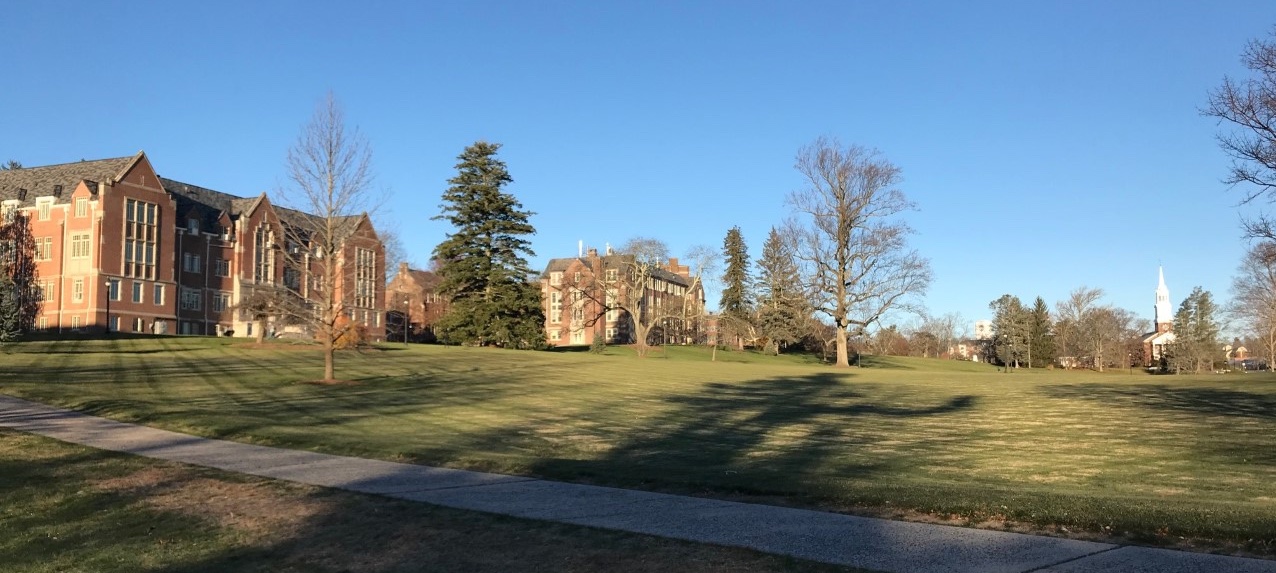
This section summarizes and interprets all historic references we have found for the stone pavilion, with special attention to finding the right name. They are arranged from oldest to youngest. There is minor redundancy to other "learn more" pages.
Our goal in naming the structure is to find the oldest well-authenticated name in the published literature and archives that can be quickly understood in modern culture. Based on all mentions, we have encountered eight nouns: shelter, building, pavilion, structure, memorial, monument, house, and hut. The word "grange," is only used as an adjective. Below is a line-by-line analysis of all published names for the structure with my interpretations and recommendations indicated the word RESULT.
1937 - May 17
The earliest and most extensive reporting of the event was an article published on the front page of the state's lead newspaper, the Hartford Daily Courant on May 17, 1937. In newsprint journalism, headlines are written by editors, photo captions by the photographers, and the main article by the reporter. All were anonymous. No sources were cited.
The headline reads: “Shelter Has Stone From Every State." The photo headline on page 2 reads: "Grange Presents Stone Shelter to Connecticut State College." The photo caption reads "Above is shown the stone shelter....Standing in front of the shelter are..." From the editor/photo-editor the only noun used was "shelter" and the only adjective was "stone."
Within the article, the following phrases and clauses are used in sequence. These were written by an anonymous reporter who was actually there, : "...construction of a stone shelter....the pavilion was accepted on behalf of the college.....I [Louis J. Tabor] dedicate yonder structure....stone building...being dedicated [Frank H. Peet].... single building" [Mr. Peet]....This building replied Dr. Jorgensen....In accepting the structure...I [Jorgensen] ... hope this building will be used [Jorgensen]...The college president then said that the stone structure....[Jorgensen]...The pavilion dedicated as the Grange's "Tribute to Agriculture."..... "Connecticut's contribution to the wall.... Scattered through the structure."
RESULT: The reporter interviewed the officials and quoted and paraphrased their remarks. The count of terms used by him/her is Building (3x), Structure (2x), Pavilion (2x), Shelter (1x), House (0x), and Hut (0x). The nouns "building" and "structure" are very general. The most common specific term is "pavilion."
1937 - May 18
UConn's daily campus newspaper, the Connecticut Daily Campus published its own article on the event without photographs. The headline reads: ""Grange Gives College Unique Stone Shelter." It's subheadline reads: "Memorial Dedication Feature Attraction." As with the Courant article from the day before, headlines are written by editors who were probably not there. Within the article are the following phrases in sequence: "...the feature event of the day was the dedication of the Grange memorial... each state appears in the Pavilion... The pavilion was the center of attraction.....the monument is a tribute to Connecticut Agriculture." The count of nouns used in these phrases is: pavilion (2), memorial (1) monument (1).
RESULT: The "Grange Memorial" is clearly a structure and a building. These nouns, however, are too general for the small hexagon. House and hut are never mentioned in either the original Courant or Conn Campus articles. Pavilion is the only name for a type of building mentioned in both articles, and is the dominant one in the Conn Campus article. The nouns "monument" and "memorial" can be used for buildings, but are often not. In contrast, a shelter or a pavilion must be a building. Based on these early documents, the noun "pavilion" is clearly preferred by both reporters working independently.
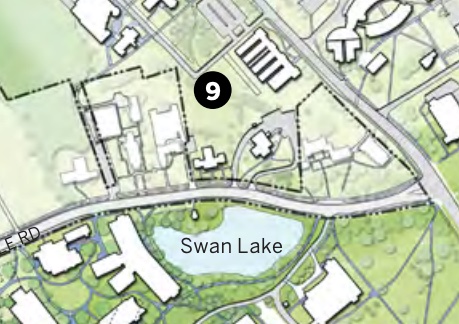
1988 - May
Figure 1.52 on page 8 of UConn's 2017 Historic District: Evaluation and Process report is titled "National Park Service Designation Map (1988)." Its caption reads: "This reference map was included with the designation form submitted to the National Register of Historic Places. It shows Contributing and Non-contributing resources, as well as the proposed district boundary." The original Designation Map, originally named as "Exhibit C: UCONN Historic District" shows a historic district boundary in dark dashed lines and a building inventory that is identical to the later 2017 Historic District: Evaluation and Process Report, strongly suggesting that the latter report is the source for the former. Credit for the map in the explanation is given as "Cunningham Associates Ltd 5/88, drawn from Campus Map, 1982, 1984."
RESULT: Being unable to locate the original NPS nomination or its consultant's report, I assume that the 2017 entry for #16 on page 26 of the Evaluation and Process report was lifted directly from the 1988 Designation Map, which cites the Cunningham Report as the original source of all information. The 2017 report lists the current and original use as "Outdoor Pavilion" and the current and historic name as "Grange Shelter Pavilion." The final noun "pavilion" is used in both cases, with the name being modified by the two preceding adjectives "grange" and "shelter," (as with the example "Big Bad Boy"), even though both grange and shelter could be stand-alone nouns. Because the entire focus of the pavilion project in on "stone," this makes it a better adjectival modifier for the final noun "pavilion."
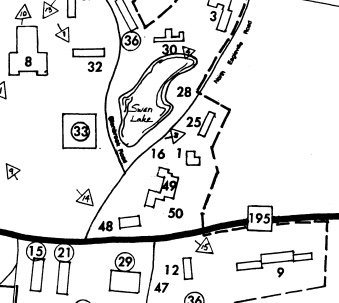
1997 - October 6
After an apparent lapse of 85 years of public communication, UConn writer Mark Roy published an article in the UConn Advance, the print predecessor to what is now the online UConn Today. His title was "'Little Stone House' represents 50 states, pays tribute to Connecticut Agriculture." Importantly, he names the feature in single quotes to indicate an informal reference. Mark's sources were the May 18, 1937 article in the Connecticut Courant, and the archive collection of Evan Hill (1980), a former journalism professor, whose papers were reviewed by Robert Thorson, revealing nothing new. Roy describes a structure that "has been referred to over the years as 'the stone shelter,' 'the stone pavilion,' and – in recent years – 'the little stone house'" without documenting any sources of quoting any witnesses.
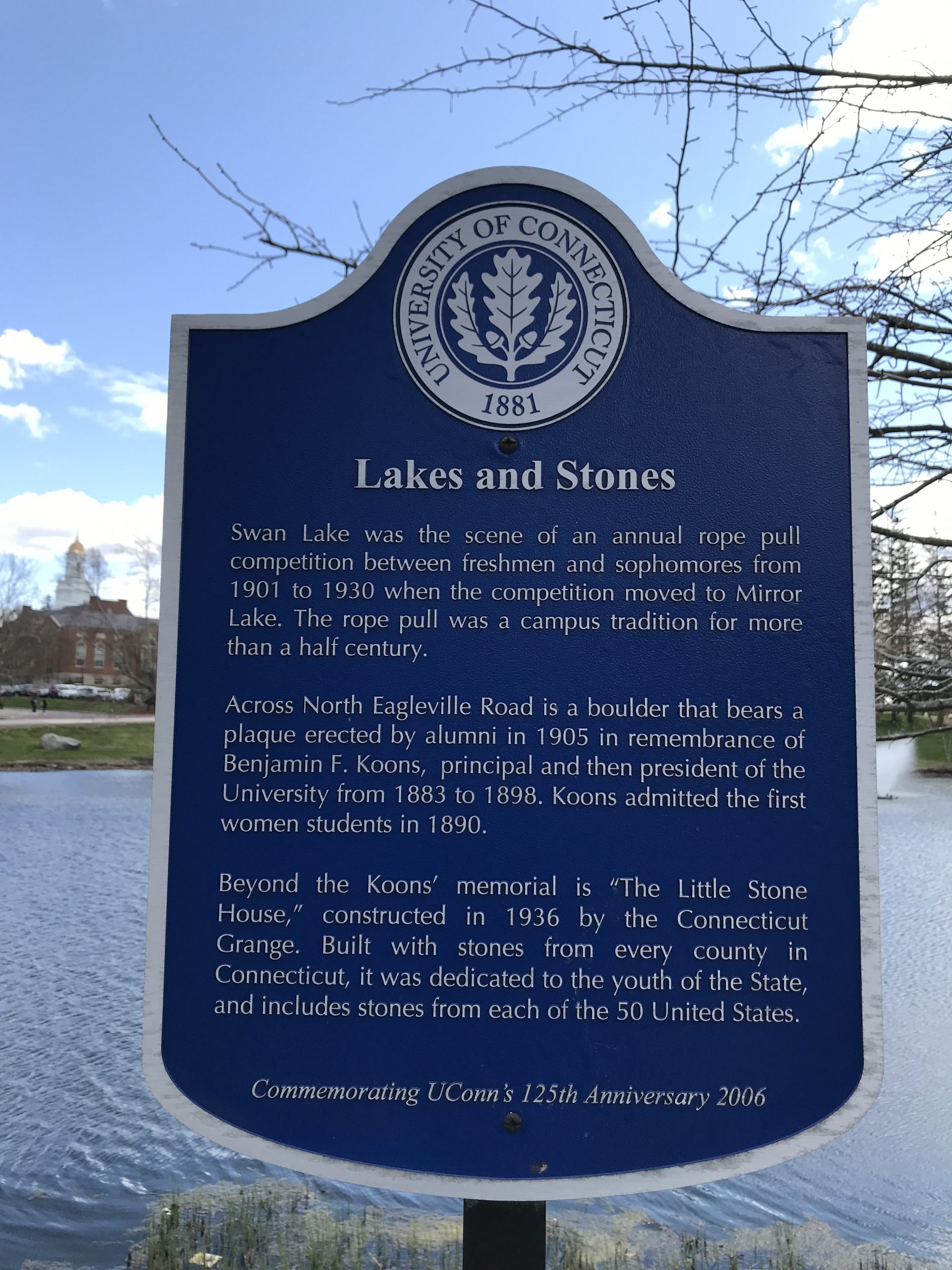
2006
To celebrate UConn's 125th anniversary in 2006, the university erected a sign above Swan Lake with this text: "Beyond the Koons' memorial is "'The Little Stone House,' constructed in 1936 by the Connecticut Grange. Built with stones from every county in Connecticut, it was dedicated to the youth of the State, and includes stones from each of the 50 United States." The only place name in quotes out of many is for the pavilion, indicating the informal use of the term "Little Stone House," meaning there is no accepted name. This usage follows Mark Roy's informal and anecdotal usage. We note that the pavilion includes a stone (singular) from every state, not stones (plural) from every state. The stone structure was dedicated in May, 1937, and could easily have been built that spring. There is no evidence for construction in 1936, though this is possible.
2012 - December 13
The text of Roy's article was republished without change by UConn Today with a different article title: "Little Stone House Turns 75." Note that in this title, the informal quotes have been dropped.
RESULT: In neither of Roy's sources was the word "house" mentioned. He must be referring to continued informal usage. Instead, the words "shelter," "memorial," and "pavilion" were used interchangeably. In the Evan Hill archive is an undated typed list of campus buildings to which he penciled this addition: "Grange Memorial Shelter." The building is conspicuously absent from maps in Hill's archive of campus maps dating from the 1920s-1940s.
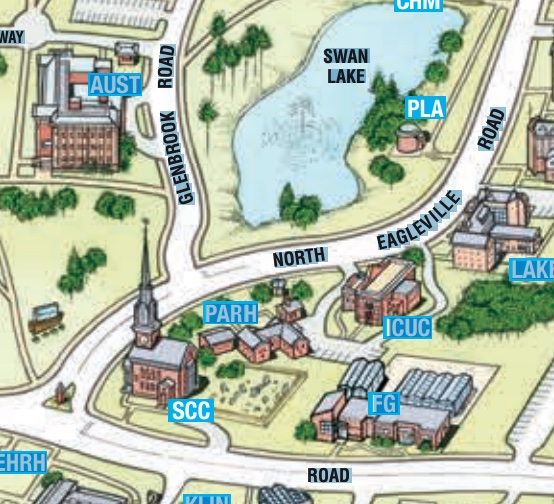
2015 - May
UConn's Campus Master Plan, with drawings by Skidmore, Owings & Merrill LLP (consultants) including its six appendices A, B, C, D, E, F, does not show the stone pavilion on the base map and many maps of the Historic District. It is not known if the building was deliberately omitted from the Master Plan or if the omission was an oversight on the part of the consultants. The building returned to list with the 2017 Historic District Report by the same consultant.
2016 - May
Robert Thorson published are article about stone walls titled "Rock On" in UConn Magazine. It includes an appendix in print and online versions requested by the editor titled: "Interactive Geological Tour." The text label for the location was "House of Many Stones" and the caption text used the name "Stone House." These names were based on guesswork and colloquial usage.
2016 - October
The report "University of Connecticut Historic District: Evaluation and Process," was released, and later revised in January 2017. Borrowing from the 1988 National Park Service designation form, they report the current and historic name as "Grange Shelter Pavilion" and the current and original use as "Outdoor Pavilion."
2018 - Summer
UConn writer Tom Breen published a fun piece for the UConn Magazine titled "Hidden UConn Quiz." It contains a short text that refers to the memorial as a "stone hut."
2020
UConn updates its official campus map and posts it on panels all across campus. At normal viewing, the pavilion is seen as tiny, unnamed dot. Close scrutiny reveals the building's hexagonal shape. The building remains unnamed and unlabeled.
SUMMARY
Though source documents will likely eventually turn up, we currently know of no other publications about the site that might help resolve its naming issue. Thorson found no mention of it in the papers of President Albert Jorgensen, who accepted the building on behalf of the university during its 1937 dedication. To date, no documentation has yet been found in the National or State or New Britain Grange Archives and we have no personal information about the stone collector, Albert P. Marsh.
Mark Roy's 1997 article was the first to span the coverage gap of 75 years. Writing anecdotally, and referencing the Connecticut Daily Campus rather than the Hartford Courant, he concluded that the building "has been referred to over the years as 'the stone shelter,' 'the stone pavilion,' and – in recent years – 'the little stone house.'" Though Thorson had lived and worked at UConn for 13 years before publication of this article, he had never heard the building named before. Authoritative reference to the words shelter and pavilion are clear. However, as of April 2022, Thorson found no reference to the final phrase "Little Stone House," which appeared when Roy dropped the informal quote marks when revisiting the article 15 years later. In Thorson's May 2016 publication, he following Roy's anecdotal name and the designation "house" Given everything above, we argue that the UConn community should return to the authoritative names of either shelter and pavilion. Of the two, pavilion was clearly preferred by the reporter-witnesses who were interviewed in 1937 for the articles.
Our preference for the word pavilion based on priority and is supported by the Historic District Evaluation and Process work prepared by Cunningham Associates Ltd. who list the use as "outdoor pavilion" and the name as Grange Shelter Pavilion." Our preference is also consistent with current uses of the words pavilion, based on Merriam Webster definitions: (3a) "a usually open sometimes ornamental structure in a garden, park" or place of recreation that is used for entertainment or shelter," and (3b) "a temporary structure erected at an exposition by an individual exhibitor." Though this is not a temporary structure, it is clearly designed as an exhibit and is an open, ornamental structure in a park-like setting. Additionally, based on definition 1a: it is "something resembling a canopy or tent" in architecture and size, respectively.